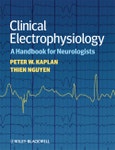Acutely ill patients present with symptoms that don’t immediately yield a diagnosis. Electrophysiological testing can support diagnosis but only if the appropriate tests are ordered. They must be properly interpreted in conjunction with the actual symptoms. Clinical Electrophysiology presents a wide range of symptoms with specific electrophysiological results. The handbook shows how the complete picture leads to better diagnostic, prognostic or therapeutic conclusions.
The book is organized by the presenting neurological problem in a clinical setting. For each case the authors provide a possible electrophysiological result. This is interpreted and tied to the patient’s symptoms to yield a clinical solution. The handbook avoids theoretical discussion to provide a direct practical guide that:
- Begins with the patient’s symptoms
- Uses a range of electrophysiological modalities
- Shows different test results for similar symptoms
- Relates clinical observation to electrophysiological testing
A final casebook section presents readers with rarer clinical challenges for self-testing.
Providing practical, to-the-point guidance on electrophysiological investigations, Clinical Electrophysiology will guide all neurologists attending acutely ill patients.
Table of Contents
Preface.Introduction.
Part 1: Central Nervous System Disorders.
Section A: Altered consciousness: confusion, delirium and unresponsiveness; agitation hallucination and abnormal behavior.
1. Diffuse and frontal fast activity - beta.
2. Diffuse slow activity - theta.
3. Diffuse slow activity - delta.
4. Frontal intermittent rhythmic delta activity.
5. Occipital intermittent rhythmic delta activity.
6. Triphasic waves.
7. Low-voltage fast record without dominant alpha frequencies.
8. Alpha coma.
9. Spindle coma.
10. Low-voltage suppressed pattern.
11. Burst/suppression.
12. Diffuse slowing - toxic encephalopathy - baclofen.
13. Diffuse slowing - metabolic encephalopathy - lithium.
14. Diffuse slowing - metabolic encephalopathy - hypoglycemia.
15. Diffuse slowing - limbic encephalopathy.
16. Focal arrhythmic (polymorphic) delta activity.
Section B: Periodic patterns of epileptiform discharges, or seizures.
17. Pseudoperiodic lateralized epileptiform discharges.
18. Bilateral independent pseudoperiodic epileptiform discharges.
19. Generalized periodic epileptiform discharges.
Part 2: Seizures.
Section A: The Diagnosis of confusional events due to seizures.
20. Frontal lobe simple and complex partial seizures.
21. Temporal lobe simple and complex partial seizures.
22. Parietal lobe simple partial seizures.
23. Occipital lobe simple partial seizures.
Section B: Status epilepticus.
24. Complex partial status epilepticus - frontal.
25. Complex partial status epilepticus - temporal.
26. Simple partial status epilepticus - parietal.
27. Simple partial status epilepticu - occipital.
28. Generalized nonconvulsive status epilepticus.
Part 3: Conditions of Prolonged Unresponsiveness.
Section A: Locked-in syndrome, minimally conscious state, vegetative state, and coma: disorders of consciousness and responsiveness.
29. Clinical definitions of impaired responsiveness.
Section B: Prolonged unresponsive states.
30. Locked-in syndrome - brainstem hemorrhage.
31. Vegetative state - postanoxia.
32. Minimally conscious state - after large, multifocal strokes.
33. Catatonia - psychogenic unresponsiveness/conversion disorder.
34. Somatosensory evoked potential Prognosis in anoxic coma.
35. Somatosensory evoked potential Prognosis in head trauma.
Section C: Evoked Potentials in Consultative Neurology.
36. Somatosensory evoked potentials in midbrain lesion - absent cortical responses.
37. Somatosensory evoked potentials in diffuse cortical anoxic injury - absent cortical and subcortical responses.
38. Somatosensory evoked potentials in prolonged cardiac arrest - absence of all waves above the brachial plexus.
39. Somatosensory evoked potentials after prolonged cardiac arrest - absence of all responses except cervical N9.
40. Somatosensory evoked potentials - median and tibial after traumatic spinal cord injury.
41. Visual evoked potentials in worsening vision.
42. Brainstem auditory evoked potentials - in worsening hearing.
Part 4: Peripheral Nervous System Disease.
Section A: weakness and/or respiratory failure in ICU and on the ward.
43. Causes of paralysis and respiratory failure in the ICU.
44. The clinical evaluation of neuromuscular disorders.
45. Laboratory evaluation of neuromuscular disorders.
Section B: Segmental weakness and/or sensory loss.
46. Evaluation of segmental peripheral neurological disorders.
Section C: Respiratory failure/diffuse weakness.
47. Amyotrophic lateral sclerosis/motor neuropathy.
48. Critical Illness neuromyopathy.
49. Brachial plexopathy.
50. Femoral neuropathy.
51. Sensory neuropathy/ganglionopathy.
52. Lumbar radiculopathy.
53. Guillain-Barre´ Syndrome - demyelinating polyneuropathy.
54. Myasthenia gravis - neuromuscular junction.
55. Myositis - irritable myopathy.
56. Statin-induced myopathy - toxic myopathy/myalgia.
Part 5: The Casebook of Clinical/Neurophysiology Consults.
57. Occipital blindness and seizures - why?
58. Unresponsiveness - coma, vegetative state, or locked-in state?
59. Unresponsiveness - organic or psychogenic?
60. Patient with a frontal brain tumor - psychiatric depression, paranoia, tumor growth, or status epilepticus?
61. Patient with idiopathic generalized epilepsy on valproate - Metabolic encephalopathy or status epilepticus?
62. Unresponsiveness - psychogenic, encephalopathy, or limbic encephalitis?
63. Respiratory weakness - toxic or metabolic?
64. Failure to wean from a ventilator/internal ophthalmoplegia - bulbar dysfunction, neuromuscular junction problem, or polyneuropathy?
65. Progressive sensory loss and painful gait - radiculopathy, toxic or infectious neuropathy, or myopathy?
66. Slowly progressive leg and arm weakness - radiculopathy, plexopathy, ALS, or CIDP/AMN?
67. Progressive thigh pain and leg weakness - radiculopathy, vasculitis, neuropathy, or amyotrophy?
Index.
Samples

LOADING...








